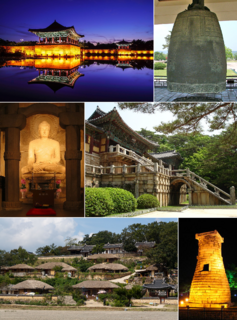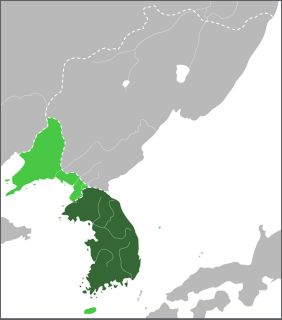| Gold Crown Tomb | |
 A gold crown excavated from Geumgwanchong tomb. National Treasures of South Korea No. 87 | |
| Korean name | |
|---|---|
| Hangul | 금관총 |
| Hanja | 金冠塚 |
| Revised Romanization | Geumgwanchong |
| McCune–Reischauer | Kŭmgwanch'ong |

The Gold Crown Tomb (Geumgwanchong), is a Silla tumulus located in modern-day Gyeongju, South Korea, the former capital of the ancient Silla Kingdom. Believed to date from the fifth or sixth century CE, the tomb was excavated in 1921. It was the first tomb that was found to contain a gold crown of the Silla royalty, and is still the largest crown excavated thus far. The tomb takes its name from the crown. [1] Over 40,000 other artifacts were recovered from the tomb, including "gold, silver, and bronze vessels, gold and silver weapons, gilt-bronze plate armor, stoneware vessels, 20,000 mainly blue Indo-Pacific beads, and horse fittings." [1] [2]

Silla was a kingdom located in southern and central parts of the Korean Peninsula. Silla, along with Baekje and Goguryeo, formed the Three Kingdoms of Korea.

A tumulus is a mound of earth and stones raised over a grave or graves. Tumuli are also known as barrows, burial mounds or kurgans, and may be found throughout much of the world. A cairn, which is a mound of stones built for various purposes, may also originally have been a tumulus.

Gyeongju, historically known as Seorabeol, is a coastal city in the far southeastern corner of North Gyeongsang Province in South Korea. It is the second largest city by area in the province after Andong, covering 1,324 km2 (511 sq mi) with a population of 264,091 people Gyeongju is 370 km (230 mi) southeast of Seoul, and 55 km (34 mi) east of Daegu. The city borders Cheongdo and Yeongcheon to the west, Ulsan to the south and Pohang to the north, while to the east lies the coast of the Sea of Japan. Numerous low mountains—outliers of the Taebaek range—are scattered around the city.
Contents
The diameter of the tomb is 45 m and the height is 12 m. Such stone mounded tombs only existed in the Shinar Era. It is believed that the tomb was varnished and lacquered. The structure of the tomb and the Buddhist influence suggest that it was built after the reign of King Jijeung. This would place the date around the 6th century, which was before the Unified Silla period. The Gold Crown Tomb has one burial mound, and the structure is simple and does not contain a special artifacts room.

Buddhism is the world's fourth-largest religion with over 520 million followers, or over 7% of the global population, known as Buddhists. Buddhism encompasses a variety of traditions, beliefs and spiritual practices largely based on original teachings attributed to the Buddha and resulting interpreted philosophies. It originated in ancient India as a Sramana tradition sometime between the 6th and 4th centuries BCE, spreading through much of Asia. Two major extant branches of Buddhism are generally recognized by scholars: Theravada and Mahayana.
Jijeung of Silla (437–514) was the 22nd ruler of the Korean kingdom of Silla. He is remembered for strengthening royal authority and building Silla into a centralized kingdom.

Later Silla or Unified Silla is the name often applied to the Korean kingdom of Silla, one of the Three Kingdoms of Korea, after it conquered Baekje and Goguryeo in the 7th century, unifying the central and southern regions of the Korean peninsula.


















